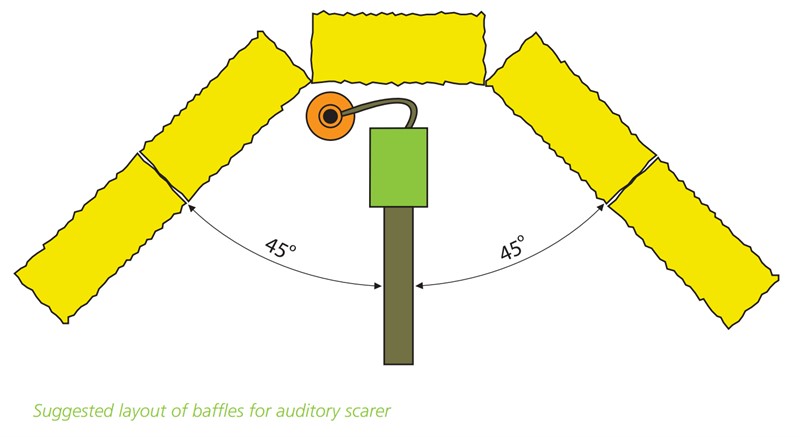If used thoughtlessly, bird scarers and deterrents can seriously annoy and disturb the public, fuelling the pressure for strict legal controls or a ban on their use.
Just a few inconsiderate actions could threaten the ability of all growers to protect their crops in the future. So please follow this code, which is designed to minimise public aggravation whilst allowing effective crop protection.
Two types of bird scarer
Auditory
These may imitate the sound of gunfire, use sirens or a constant hum, or mimic the distress call of a bird.
Visual
These rely on birds’ fear of humans, other predatory birds and sudden movements.
Some scarers and deterrents combine sound and visual stimuli.
Avoid causing a nuisance with your bird scarer
Try to minimise the impact of auditory scarers on your neighbours and consider other ways of scaring birds.
- The disturbance of scarers on nearby hospitals, homes or schools should be minimised. Place the scarers as far away as you can, point them away from neighbours, and use baffles.
- Avoid using auditory scarers within at least 200m (220 yards) of sensitive buildings before 7am, or before 6am elsewhere, when sunrise is earlier. Use another method in the early morning and do not use after 10pm, or when sunset is later.
- Try not to use auditory scarers on Sundays. Try another type of scarer instead.
- Consider the lie of the land, atmospheric conditions and plant cover.
- Think of the prevailing wind when siting scarers. Noise travels much further downwind. Take particular care with devices that swivel with the wind.
- Ensure that mechanical timers are regularly re-set because of changes in sunrise and sunset times.
- If a photoelectric cell controls the gun's operation, make sure that this is kept clean and free from obstruction. If you can, use a mechanical timer to back up a photoelectric switch.

Absorbent baffles
Use reflective or absorbent baffles (corrugated iron or straw bales, like the above illustration) to guide the sound onto your field and away from neighbours. These can be very effective in reducing noise levels in the required direction.
Contact details of the person responsible
Ensure that your neighbours have the name of a responsible person to contact if the control on a scarer fails. Also display the name and phone number at the nearest point of public access, or inform the local Environmental Health Department where the scarer is located and give them contact details of the person responsible.
Ensure that scarers are properly maintained and checked regularly to detect any malfunctions that could cause complaints.
Increasing effectiveness
Reinforce the effects of the scarer by shooting, so that the noise is associated with real danger. Prolong the effectiveness of scarers by hiding them – but not where they could cause a risk of fire.
Try placing a scarer inside a brightly-coloured container and place several similar but empty containers in the field. Occasionally move the scarer from one container to another.
Reducing the need for bird scarersÂ
It may be possible to reduce the need for scarers. You can try planting (where your crop rotation allows) crops vulnerable to bird damage next to roads or other locations where the birds will be disturbed.
If you're planting new areas of valuable crops (particularly orchards or soft fruit trees), try and locate them as far away from buildings where people sleep or where quiet is important, so if you need to use auditory scarers their impact will be minimised.
You can consider growing small-scale crops under netting. Fencing or electrified netting can protect crops near watercourses from swans and geese. Strings or tape suspended roughly 50 metres apart may prevent waterfowl flying into crops.
Choosing bird scarers
Use as many different types of effective scarers as you can – visual, auditory and repellents can all have a role to play.
Birds quickly get used to scarers, so it’s a good idea to use a variety of scarers to maintain their novelty.
Auditory bird scarers as a last resort
Use auditory scarers as a last resort after trying alternatives. Do not site scarers prone to theft where they can easily be stolen.
As soon as an auditory scarer loses effectiveness, replace it with another of a different type, otherwise it could signal a good feeding area.
Propane gas guns
Think carefully about the uses of propane gas guns. Inconsiderate use may lead to complaints and you may have to appear in court.
Do not fire them more than four times in any hour (remember to consider situations where several guns protect a single field).
Birds can take more than 15 minutes to regroup. If the intervals are too short, the birds will quickly get used to the scarer. All the reports from a multiple discharge gun should count as one report if heard within 30 seconds.
Talk to your neighbours
Talk to neighbouring farmers to ensure that between you, you do not cause a nuisance.
Using bird scarers of all typesÂ
- Use scarers as infrequently as possible.
- Determine when the crop is most vulnerable and only use scarers then. However, if geese are seen near a crop, scarers should be positioned immediately.
- Prolong the effectiveness of a scarer by varying the type and positioning of scarers.
Bird scarers and rights of way
- Scarers are intended to frighten birds, not visitors to the countryside. Try to avoid surprising passers-by.
- Try to avoid positioning auditory scarers adjacent to rights of way. Consider warning users of their presence.
- Remember that horses are easily frightened and can bolt or unseat their riders. Do not position the scarers near roads or bridleways usually used by riders.
Lessen the potential danger
- Maximise the distance between the scarer and the road or bridleway.
- Point the scarer away from nearby roads or bridleways.
- Where appropriate use a baffle (as illustrated above).
- Consider displaying temporary signs to warn riders. Don’t forget to remove these after use.
